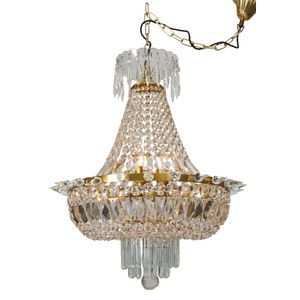Crystal Basket Chandelier with Lustres and Brass Ring
A Czech crystal basket chandelier, mid 20th century, the central column supporting a scalloped bobeche adorned with crystal lustres, above a crystal basket, incorporating a gilded brass ring emanating crystal spikes, above a lower tier of crystal droplets, 70 cm high, 140 cm high with canopy, 60 cm diameter.
You must be a subscriber, and be logged in to view price and dealer details.
Subscribe Now to view actual auction price for this item
When you subscribe, you have the option of setting the currency in which to display prices to $Au, $US, $NZ or Stg.
This item has been sold, and the description, image and price are for reference purposes only.
- Lustres on Chandeliers and Candelabra - Lustres, as seen on candelabra and chandeliers are the glass or crystal drops or pendants that hang from the arms or branches of the fixture. They are often arranged in a decorative pattern and can range in size and shape, from small teardrops to large spheres.
Lustres are designed to catch and refract light, creating a sparkling, shimmering effect. The drops are typically made of cut glass or crystal, which has a high refractive index, meaning that it bends and reflects light in a particularly beautiful way. The drops may be clear or coloured, and may be smooth or faceted.
Lustres have been used in chandeliers and candelabra for centuries, and were particularly popular during the Baroque and Rococo periods. They continue to be used today in both traditional and modern lighting designs, adding a touch of glamour and sophistication to any space. - Gilding - Gilding is a method of ornamentation whereby a thin sheet of gold metal is applied to items made of wood, leather, ceramics, glass and silver for decorative purposes.
For furniture including mirrors, the sheet of gold is usually applied over a coating of gesso. Gesso is a mixture of plaster of Paris and gypsum mixed with water and then applied to the carved wooden frames of mirrors and picture frames as a base for applying the gold leaf. After numerous coats of gesso have been applied, allowed to dry and then sanded a coat of "bole", a usually red coloured mixture of clay and glue is brushed on and allowed to dry, after which the gold leaf is applied. Over time parts of the gilding will rub off so the base colour can be seen. In water gilding, this was generally a blue colour, while in oil gilding, the under layer was often yellow. In Victorian times, gilders frequently used red as a pigment beneath the gold leaf.
Metal was often gilded by a process known as fire gilding. Gold mixed with mercury was applied and heated, causing the mercury to evaporate, the long-term effect of which was to kill or disable the craftsman or woman from mercury poisoning. The pursuit of beauty has claimed many victims, not the least of which were the artists who made those pieces so highly sought after today. - Tier - One or more under-shelves of a table or cabinet.
This item has been included into following indexes:
